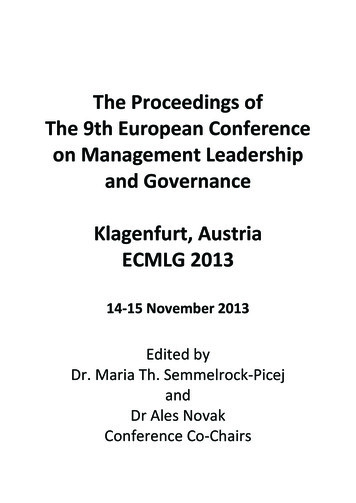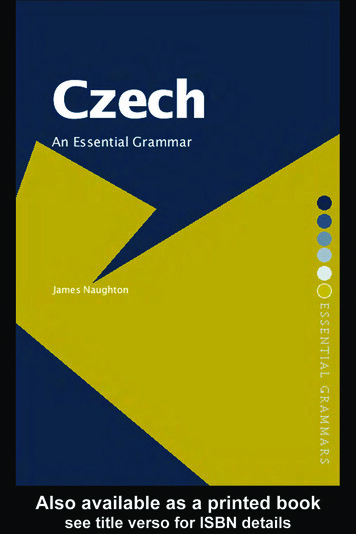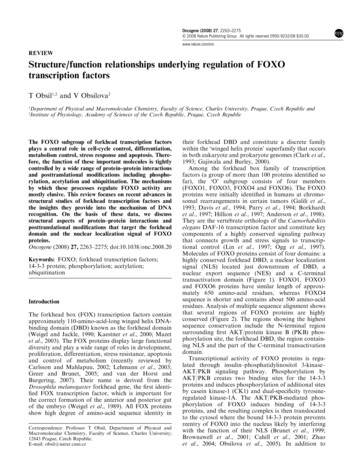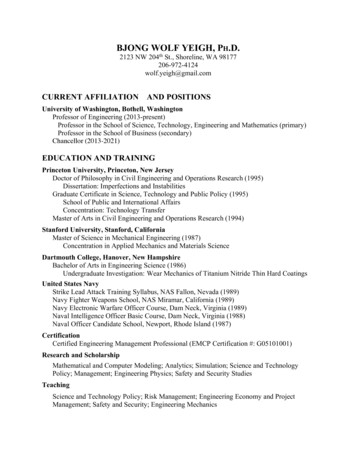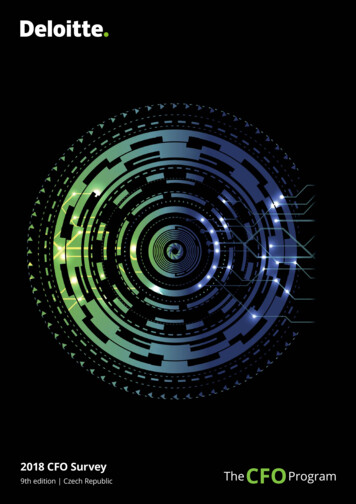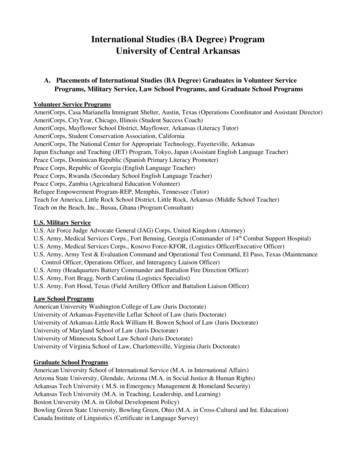
Transcription
Acta Informatica Pragensia2021, Volume 10, Issue 3, pp. 236–256Special Issue: Perspectives of Social leOpen AccessCzech and Slovak Educators' Online Teaching Experience:A Covid-19 Case StudyJozef Hvorecký 1 , Michal Beňo 1 , Soňa Ferenčíková 2Renata Janošcová 3 , Jozef Šimúth 4,Institute of Technology and Business in České Budějovice, Okružní 517/10, 370 01 České Budějovice, Czech RepublicFaculty of Commerce, University of Economics in Bratislava, Dolnozemská cesta 1, 852 35 Bratislava 5, Slovak Republic3 Faculty of Economics, University of Finance and Administration, Estonská 500, 101 00 Prague 10, Czech Republic4 School of Management, City University of Seattle in Slovakia, Panónska cesta 17, 851 04 Bratislava, Slovak Republic12Corresponding author: Jozef Hvorecký (hvorecky@mail.vstecb.cz)AbstractThe surge in interest in online teaching increased not only due to the pandemic. It had been growingeven before. The main objective of this study is therefore to explore how online teaching has changed.It addresses experience and opinions of educators of Czech and Slovak universities in the period fromthe first days of the COVID-19 lockdown (March 2020) till the peak of its second wave (May 2021). Toexamine the impact of disharmony, the authors investigated Czech and Slovak university educators’activities and behaviour during their online teaching. A descriptive statistics approach was applied. Atotal of 172 educators participated in our online survey. Our results reveal that online teaching hasbecome a fundamental component of their education. Our outcomes demonstrate their low preparationfor this unexpected event as well as their quick adaptation to the new situation. Additionally, dataindicate that their difficulties reconcile their previous experience and teaching practices with onlineteaching. Finally, they show that about half of them are still sceptical about the future of onlineeducation and dream of return to traditional teaching. Our results also indicate that universities shouldfacilitate their efforts in developing online education methodology and overall support to theireducators.KeywordsCOVID-19 pandemic; Experience in online education; Higher education; Online teaching; Socialinformatics.Citation: Hvorecký, J., Beňo, M., Ferenčíková, S., Janošcová, R., & Šimúth, J. (2021). Czech and Slovak Educators' Online Teaching Experience:A Covid-19 Case Study. Acta Informatica Pragensia, 10(3), 236–256. https://doi.org/10.18267/j.aip.162Special Issue Editors: Vasja Vehovar, University of Ljubljana, SloveniaZdenek Smutny, Prague University of Economics and Business, Czech RepublicAlice R. Robbin, Indiana University, USAAcademic Editor: Zdenek Smutny, Prague University of Economics and Business, Czech RepublicCopyright: 2021 by the author(s). Licensee Prague University of Economics and Business, Czech Republic.This article is an open access article distributed under the terms and conditions of the Creative Commons Attribution License (CC BY).
Acta Informatica PragensiaVolume 10, 20211 IntroductionAlready before COVID-19, distance education was widespread in e-coursework among non-traditionalstudents (Allen and Seaman, 2010), in particular among those who are employed or have familyobligations (Aslanian, 2001) and/or are older, have a full-time job, or have other challenges in coming tothe campus (Makoe et al., 2008). One can say that education and technology become inseparably linkedin the field of distance and lifelong education (Lipovská et al., 2014). Further, the conceptualization ofsocial informatics was exposed with the increasing role of information and communication technologies(Vehovar, 2006). Our paper is in the vein of Kazmer and Haythornthwaite’s (2005) statement that onlineeducation calls for attention from various perspectives looking at the transformative effects of this socialand technological innovation. Barkhatova et al. (2017) emphasize the society’s requirements for qualityinformation training of a personality.The COVID-19 pandemic introduced the same relation into regular in-class education. It forced alleducational institutions to replace their standard (face-to-face) mode of education to the online (face-todisplay) mode. This replacement has been a common concern among educators for long (Conrad, 2004).Classrooms had to be set up at home-based premises, which offered an opportunity for innovation andcreativity. Compared to previous modal shift, which had taken decades, the recent change was suddenand massive. The authors agree with Dhawan (2020) that e-learning is a necessity under suchcircumstances. Educators were requested to change their teaching mode to online education even atschools and universities with no previous experience of it. In accordance with Hvorecký and Beňo (2021,p. 300), e-learning and e-working resemble each other in “giving up daily interactions with peoplewho are working in the same location”. They further explain that “for some types of students(especially for adult working professionals), combined (on-site and online) learning and solely onlinelearning is preferred as the only possibility to complete or continue courses or education. For somestudents, such as recent high-school graduates, an experience of learning and living in campus ispreferential.” In the post-COVID period, new quality and service will therefore be required (Currie et al.,2020).Departments of all Czech and Slovak universities had to undergo the same adaptation. Based on twodifferent reports addressing pre-COVID online education (Beblavý et al., 2019; Preply, 2020), one canconclude that teachers in the Czech and Slovak Republics preferred in-class teaching because (a) they were usedto it and (b) no-one had ever asked them to do anything else.Below, we study several aspects of the change and its potential effects on future university functions. Our researchaddresses the periods of the first and second pandemic waves (March 2020 to May 2021 with a few shortinterruptions). The pandemic offered an exceptional opportunity to analyse processes evoked by thissudden external factor. To study its commencement, progress and effects, we administered an onlinesurvey addressing the activities of university educators, their experience with online educational methodsand presence/absence of support from their university. During that period, they had enough time to learntheir lessons necessary for developing future conduct scenarios at both individual and organizationallevels.The Roman philosopher Seneca said: “Luck is what happens when preparation meets opportunity”. Theextracted facts allow us to make conclusions about the preparation of universities and their staff forproviding large-scale and lasting online education. Janošcová and Hvorecký (2020) suggested thatuniversities should design and develop online education strategies. In the questionnaire, the educatorsexpressed their opinions on their previous experience, training and institutional support during thepandemic. As our results indicate, the suggested systematic policies have rarely been applied by Czechand Slovak universities before. In our research, we were therefore more interested in the organization ofonline education and its performative processes and support than its methodology because it has to behttps://doi.org/10.18267/j.aip.162237
Acta Informatica PragensiaVolume 10, 2021very specific for each and every course. Without question, methodological issues are extremely importantbut our snowball sample formation would not allow us to address detailed questions about it. As a result,we included only those issues which are shared by all online courses.The target of our survey was the universities’ social, organizational, managerial and educational processesfrom the social informatics point of view. Social informatics research studies the social context ofinformation technology development and concentrates on significant influences of ICT on human beings,i.e., on their consequences for work, organizations and other social relationships (Kling, 1999). Eventhough course design and development, testing and examinations, for example, are an important part ofeducation, they are too specific for each subject. Thus, we focused on a higher (more general) level, i.e.,whether educators’ experience with online teaching will affect their future educational practices.There is a reason for skipping the technology infrastructure issues, too. Czech and Slovak universitieshave been building their networking infrastructure since the 1970s and updating it regularly. As a result,all departments are equipped and connected fairly well. One could question students’ access from home.Eurostat data (2021) show that the Internet environments in both the Czech and Slovak Republics are welldeveloped, too. Before the pandemic, the saturation of households with the Internet was 88% in the CzechRepublic (in 2019) and 85% in Slovakia. The proportion grew during the COVID-19 period to 89% in theCzech Republic and 91% in Slovakia. The Slovakian leap of 6% indicates that parents who are interestedin their children’s education (and/or were forced to work from home) support their households withtechnology to build optimal conditions. As the EU27 average in 2021 is 89%, the figures indicate acomparable saturation with the Internet in our study countries and, consequently, good preconditions foronline education among university students.Our main question is whether university students could study online comfortably and efficiently. Inparticular, we ask whether the universities had built a relevant scaffolding for online study prior to thepandemic, how they strengthened it during the period and, finally, whether they are ready to learn fromit and to expand the weight of online education. University students themselves are not the subject of ourstudy. We have studied the flow of online education and its changes during the pandemic. Its smoothflow is a duty of universities, not of students. Moreover, young people have usually fewer problems withchanging environments and rules.A recent study highlights that for the younger generation, and especially for vulnerable adolescents, theCOVID-19 crisis poses significant risks in the field of education among other fields (OECD, 2020). So, ourpriority was concentrated on the parts of the process which would be likely more affected. Today’sstudents belong to Generation Z dubbed “digital natives” (Turner, 2015); they are used to onlinecommunication much more than their teachers. Potential problems could relate to their previouspreparation. Nevertheless, it is not bad. The Czech Republic’s PISA (Programme for International StudentAssessment) results are average and Slovakia’s are a bit lower. In addition, preconditioning knowledgecan hardly influence the outcomes substantially because for every individual it remains the sameregardless of his/her study mode.On the other hand, the teachers might face difficulties more easily – not because of technology but becauseof methodology. Above, we referred to studies of Beblavý et al. (2019) and Preply (2020) pointing to it.Moreover, Hall et al. (2019) found out that passive methods of education prevail at the Slovak universities– with lecturing dominating above all. In bachelor and master programs, 83.8% of educators apply it intheir courses. Student-centred learning methods based on dialogue are less frequent. This approachcontradicts the philosophy of virtual classrooms (Palloff and Pratt, 2007; Salmon, 2011), where theeducator is not the sole source of information. He/she rather plays the role of moderator and facilitator.As we show below, the gap in teachers’ experience was reflected in their behaviour.https://doi.org/10.18267/j.aip.162238
Acta Informatica PragensiaVolume 10, 2021In our paper, we study the activities of university educators, their stepwise understanding of onlineeducational methods, and their support from the university. We investigate their behaviour during thepandemic period and ask whether they learnt any lessons necessary for developing their future scenariosat both individual and organizational levels.1.1Online learning and teaching becomes crucialAs Kling et al. (2005) underline, “ICTs do not exist in social or technical isolation. Their ‘cultural andinstitutional contexts’ influence the ways in which they are developed, the kinds of workableconfigurations, how they are implemented and used, and the range of consequences that occur fororganizations and other social groupings”. Our paper focusses on the influence of ICT on educationalprocesses and their changes as a result of the pandemic.As education is the principal function of any university, it had played a significant role in university lifeeven before the COVID-19: technology for teaching remotely was on a constant rise (Duffin, 2020).Similarly, Wegner et al. (2019) state that technology used to deliver coursework in higher education hasseen a veritable explosion. According to Valverde-Berrocoso et al. (2020), Massive Open Online Courses(MOOC) dominated as the e-learning modality. All this has had effects on university life.In 2017, 33.5% of American higher-education students were enrolled in some form of distance or onlinelearning. Since 2020, 98% of universities have moved to online classes (ThinkImpact, 2021). Onlinelearning increases retention (Ditacademy, 2017). Abou El-Seoud et al. (2014) observe thatutilization of interactive features of e-learning increases motivation of undergraduate students for thelearning process. Burçin Hamutoğlu et al. (2021, p. 111) observe that students with previous Internetbased education experience have a higher level of awareness of the methods and techniques usedin the course. Another study from Slovenia indicates that the overall perception in relation to ecourses, their coherence with face-to-face teaching and the teacher’s responsiveness had asignificant impact on the students’ perception of the usefulness (Aristovnik et al., 2016). A recentstudy stresses that e-learning adoption and e-learning attitude do not directly predict academicachievement in e-learning but enhance digital readiness and academic engagement (Kim et al., 2019).According to Zolochevskaya et al. (2021), ICT has a substantial positive effect on the total successof students in universities. Latest research confirms the overall positive attitude of students andfaculty members towards the use of online and e-learning modules/methods (Gerasimova et al.,2018). Butorac et al. (2011, p. 426) reveal that students value the most completeness, organizationand design of educational materials, as well as teachers’ online engagement, especially in goode-course management, regular communication and timely provision of feedback. The authorfurther discovered that preferences for exclusively online and/or blended learning are dominantin a group of students having better average study grades (A or B), as well as in a group havingshorter study experience.Carey (2020) explains that colleges exist in a state of constant electronic connectivity. He furtheradds that online education accomplishes at least three distinct things: distance, scale and personalization.Liguori and Winkler (2020) highlight that innovative solutions by institutions are crucial. According tostudents, online learning is very helpful to 40% of them (Duffin, 2020); 50% of them were active in onlinecourses on various platforms (Keegan, 2021) and women are more likely to participate in distance learning(NCES, 2019). Current data from one study demonstrate that there are equal opportunities for malesand females in e-learning, and that female students use e-learning platforms very well (VadakaluElumalai et al., 2020, p. 744).https://doi.org/10.18267/j.aip.162239
Acta Informatica PragensiaVolume 10, 2021Social informatics studies related to universities are done worldwide. A study from Dubaidemonstrates that e-learners have shown a very high level of understanding concerning the potentialand value of e-learning (Gokah et al., 2015). Gedeon and Khalil (2015) stress that the primarybarriers to e-learning development persist due to non-implementation of e-learning regulationsby governments. A recent study from Iran highlights cultural barriers to e-learningimplementation, too (Ahmadi and Nourabadi, 2020). Franklin et al. (2018, p. 94) recommend themanagement of King Khalid University to ensure that potential learners of the university acceptlearning via web-based technology. In addition, university management should certify thatlearners and instructors have the required technical competency. Environments supportingsocial contacts can also reduce some negative consequences of online education, e.g., feelings ofisolation (Dávideková and Hvorecký, 2017).1.2 Reasons for having a university-wide online education strategyThe positivist’s view of classrooms as teacher-centred environments contrasts with the constructivist’sone presenting learning as a student-centred method (King, 1993). Barker (2003) accented a shift fromteacher-centred instruction to learner-centred instruction, too. Espinoza (2012) suggests another paradigmshift: learning from technology to learning with technology. Chizmar and Williams (2001) are of theopinion that learning pushes technology. Online learning in higher education boosts access for all presentlearners and as such provides a new access tool for previously underserved learners (Sener, 2010).Mitchell (2014) emphasizes that following online teaching strategies could enhance students’ perceptionof engagement, increase retention and satisfaction. According to Cox and Marshall (2007, p. 3), “skilfuluse of ICT (Information and Communication Technology) by the teachers links to careful pedagogicalautomation, capacity, range and interactivity”. HEA (2015, p. 4) emphasizes: “When well supported,[flexible learning] positively impacts recruitment, retention and progression; widens participation; andoffers opportunities to learners of all ages, backgrounds, ethnicities and nationalities”.Such a substantial change of university functions must be made systematically as part of a universitywide online educational strategy. Under that, we understand a set of written organizational guidelines aswell as written and unwritten methodological procedures serving as a basis for standardized executionof a study program over the Internet. It specifies design, development and continuing improvement ofboth (online and on-site) streams of courses, synchronizes their specific activities, optimizes them andcoordinates them in the time schedules of all campuses sharing the courses. When well developed, itallows simple and smooth transfer between modes and locations. According to Hvorecký et al. (2021), thekey components of the strategy are: Acceptance of the strategic importance of massive online education leading to a shift in theeducators’ way of thinking and resulting in the recognition of online education as an equalalternative to standard classroom delivery.Creation of supportive digital content for two (i.e., online and on-site) versions of each course withidentical learning objectives using optimal specific tools of each particular mode.Organizing the system of staff development and in-service teacher training based on elaboratedmethodologies, long-term experience and best practice.Development of virtual classrooms, laboratories and courses combining the specific course contentand a standardized template for all courses. Such uniformity minimizes the time waste caused bythe necessity to learn to operate the course.Excellent execution of online courses covering all their functions (content delivery, teacher-studentcollaboration and feedback, transparent grading, etc.) A quality assessment team should controltheir excellence and guarantee that online education will achieve its expected level.https://doi.org/10.18267/j.aip.162240
Acta Informatica Pragensia Volume 10, 2021Sustainable development of online methodology and its practices addressing uninterruptedexecution of courses and their systematic improvement and innovation.In accordance with Andrade (2016), common higher education traditions and cultures represent afundamental obstacle to online learning paradigms. We will present some of their consequences below.2 Materials and MethodsThis study adopted a quantitative approach. From 20 April to 10 May 2021 (at the peak of the second waveof the COVID-19 pandemic), an online web survey was distributed among Czech and Slovak educatorsaged 20 years or older. A rigorous approach to research based on a large sample, a targeted survey methodand reducing nonresponse error (Ponto, 2015) was implemented. An English questionnaire was formedfirst but was then translated into both official languages of the countries where the survey was conducted.A set of open-ended and closed-ended questions with Likert scales and numerical ranges were includedin the questionnaire. The questionnaire design was tested with a group of respondents before itsfinalization. Educator demographics such as age, gender, type of contract, country and type of universitywere collected at the beginning of the survey. Responses to the questionnaire were anonymous andvoluntary. This fact was emphasized in the e-mail invitation to the survey. All participants who engagedin the survey were fully informed regarding confidentiality, privacy, sensitivity and data protection. Aconsent form was issued.2.1 SampleData relevant to the six above strategic components were collected from university educators as asystematic sample. Obviously, this sample is seen as unrepresentative of the entire population becausethere was no time for a prolonged preparatory period which would be formed using one of the followingways:a) address all university educators in both countries, orb) form a stratified sample from a well-specified set of universities.Snowball sampling was implemented to gather information to access specific groups of people (Naderifaret al., 2017). As the authors of this paper are experienced online educators with many contacts amongonline education specialists around both countries, they addressed them and asked for distributing thequestionnaire to as many colleagues as possible (which is the principle of so-called exponential nondiscriminative snowball sampling). The initial group consisted of 50 specialists from the Czech Republicand Slovakia (25 from each country). To nudge them and their respondents, we promised to send them acopy of the paper (Hvorecký et al., 2021) that served as a guideline for our questionnaire design. A dozenof them applied and received it.A total of 172 educators responded (67 from Czech universities and 105 from Slovakian ones). These arethe key characteristics of the group: 146 educators came from public universities, 26 from private ones,there were 108 females and 64 males,the age group of 40-60 had 88 members, the 20-39 group 44 persons, the 60 group numbered 40educators,154 teachers worked full-time and 18 part-time.2.2 Data analysis and evaluation of survey resultsDue to the snowball sample, we have no opportunity to know how representative of the population thesample is. For this reason, our principal research method is descriptive statistics with numbers that areused to summarize and describe unrepresentative data which do not involve generalizing beyond thehttps://doi.org/10.18267/j.aip.162241
Acta Informatica PragensiaVolume 10, 2021data at hand. Our extensive set of data covers demographic data, preferred teaching modes prior to andduring the pandemic, the adaptation period and its effects on the teachers’ classroom activities and theirpotential development in the future. In most cases, we grouped the teachers’ responses, aggregated andthen interpreted them. To derive a true picture, we often combined several of these outcomes, juxtaposedthem – and reinterpreted, if needed.We concentrated on the following questions: Have educators preferred synchronous (real-time interaction with a group) or asynchronous (noreal-time interaction with a group) communication? What are the differences between the prepandemic and pandemic periods?Will they apply some online teaching elements in their teaching even after the pandemic and how?Do teachers feel the need to develop their skills in e-pedagogy in the future?Respondents may give consistently high or low ratings, reflecting the evaluator’s bias that detracts fromthe validity of the results (Isaac and Michael, 1997, p. 137). Generally, in terms of coverage, online surveysusing only samples of digital users cannot be not generalized to the general public (Fricker, 2015).In our survey, the educators expressed their interest in presenting their opinions in order to study thecurrent state of online education and its near future. In our survey, the higher response rates wereassociated with lower nonresponse bias. The authors did not follow the myopic focus on large sample sizeand the idea that a larger sample possibly equates to sample representatives and generalizability.In the Discussion section, we consider the degree of their validity. We sum up the given values and thenprocess them in order to accumulate the educators’ individual opinions and feelings to thosecharacterizing the group. As their predictive value is restricted by the method used, we denote them as“indicators”. In the Discussion and Conclusion sections, we analyse to what degree these indicators canbe extrapolated to the entire university system despite their subjective character.3 ResultsIn this part, the authors refer to the process of analysing data obtained from the educators.3.1 Respondents’ experience of online teaching prior to the pandemic andtriggered changeIt is notable that the educators in our sample had generally not been prepared for online teaching. In total,more than half of them (51.8%) had no previous experience of teaching remotely. Only 23.8% of themteach remotely regularly and 24.4% occasionally. Across the board, the results reveal a low portion ofonline education at Czech and Slovak universities. A more detailed picture indicates proportionaldifferences between the countries; see Table 1.Table 1. Online teaching experience by country.CountryCZSKEducatorsN67105NeverN (%)42 (62.7%)47 (44.7%)OccasionallyN (%)17 (25.4%)25 (23.8%)RegularlyN (%)8 (11.9%)33 (31.4%)There is a difference. The proportions of those teaching occasionally is practically the same but there isapproximately a 20% difference in favour of Slovakia in the two remaining characteristics. In total, 83 (25in the Czech Republic and 58 in Slovakia) educators had certain experience of online teaching.https://doi.org/10.18267/j.aip.162242
Acta Informatica PragensiaVolume 10, 2021Table 2 shows their teaching modes used prior to and during the COVID-19 pandemic. Notice that thesum of values in the first row is greater than 83; in the second row greater than 172. This is caused by thefact that some of them practised their combinations. Notice also that the percentages in the first row arecounted out of 83, in the second one out of 172.Table 2. Online teaching modes before and during the pandemic.PeriodBeforeDuringNumber of teachers using the given online teaching modeSynchronousAsynchronousCombinedOther11 (13.3%)55 (66.3%)14 (16.9%)3 (3.6%)161 (93.6%)85 (49.4%)94 (54.7%)7 (4.1%)All four increments are substantial. On the other hand, their expressive value can be questioned withregard to the fact that their growth is a result of external powers.Our triad of questions (on the synchronous and asynchronous modes as well as their combination) can beseen as tricky and superfluous. Nevertheless, it was done on purpose. As we wanted to get a realisticpicture, it was posted to make certain that the respondent will not understand synchronous andasynchronous modes as exclusive options. All responses with Yes in both variants A and B were includedin the sum as well as those in which the person only marked Yes at “combined”. Course content deliveryusing other (i.e., less standard) methods includes Skype or social media communication, YouTube videosand online tests. They were usually exploited as emergency solutions in the absence of more standardoptions.3.2 Specific change of online teaching modesA deeper look at Tables 1 and 2 in the previous chapter shows that just 11 out of 83 then teaching educatorspreferred collaborative tools with a synchronous communication (MS Teams, Google Meet, Zoom,TeamViewer, BBB, etc.) prior to the pandemic. The majority used asynchronous communication vialearning management systems (LMS) such as Moodle, Blackboard, TalentLMS, etc. A combination wasused by 14 educators. Only 3 educators preferred another format, especially email or phone calls.Table 2 above demonstrates a sudden change in the proportion between the synchronous andasynchronous modes. The educators exploited the synchronous mode (161) and the combined mode (94)more frequently than the purely asynchronous one (85). The greatest share is evidently observed in thesynchronous mode, in which the teachers and their students are present in a face-to-display teachingenvironment. It grew almost 15 times more compared to the pre-COVID period. There is an explanation:As mentioned above, the number of experienced online educators was not high. Hall et al. (2019) point tothe prevalence of lecturing at Czech and Slovak universities. A person accustomed to it would hardlychange his/her habits instantly upon an order. In such a situation, he/she logically tries to mimic his/herhabits to the maximum degree. The most natural choice is lecturing via a synchronous tool.There is a rise in asynchronous online education, too, but its growth was much smaller. It may look as asurprise because Moodle has been widespread more at Czech than Slovak universities (Moodle, 2021). I
Eurostat data (2021) show that the Internet environments in both the Czech and Slovak Republics are well-developed, too. Before the pandemic, the saturation of households with the Internet was 88% in the Czech Republic (in 2019) and 85% in Slovakia. The proportion grew during the COVID-19 period to 89% in the Czech Republic and 91% in Slovakia.
